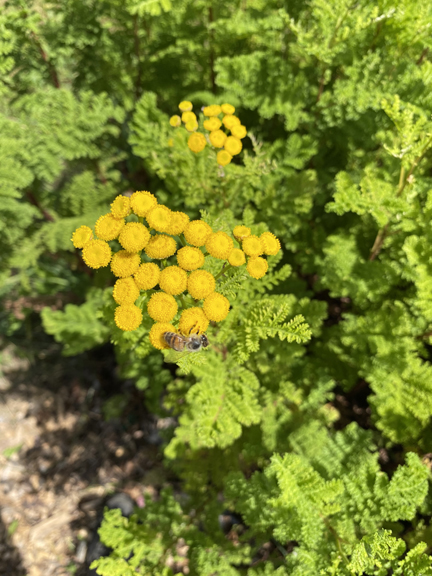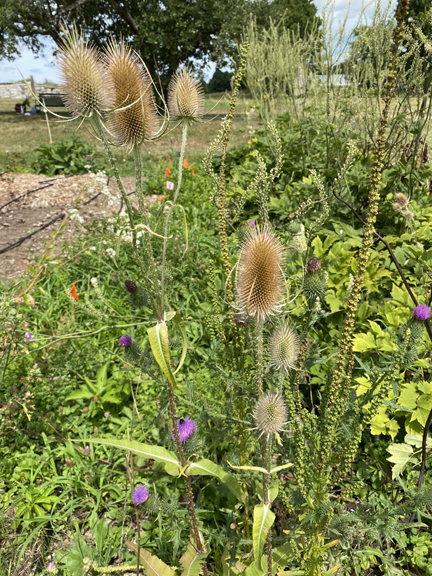Hugelkultur Garden Technique Helps Newest Pollinator Bed Thrive


Hugelkultur garden technique helps newest pollinator bed thrive at Canterbury Shaker Village
By Jennifer J. Montgomery, Natural Resources Steward 2019
If you think a hot, dry, roadside spot sounds like a tough location to plant a lovely pollinator garden, you’d be right—usually. But if you’ve visited Canterbury Shaker Village this summer or fall, you’ve probably seen the lush, bloom-filled pollinator garden buzzing with life—on a hot, dry, roadside corner of the Village’s Education Center.
The lushness and success of the year-old garden is all the more impressive given the deepening drought that has afflicted much of New Hampshire all summer long. The key to the garden’s success in that challenging location in this very dry summer is hugelkultur, a gardening technique that uses layers of rotting twigs, branches, and even full logs as a nutrient- and moisture-dense fill layer under the compost and topsoil in which the plants grow.
Mike Barwell, a Master Gardener enrolled in the 2019 Natural Resources Stewards class that studied at the Village, worked with local permaculture gardener and Natural Resources Steward Laurie Lockwood to design the pollinator garden. Barwell and Lockwood led Steward students in the planting of the garden in late September of last year.
Barwell said they transplanted flowers from other gardens at the Village and added additional plants that the Shakers themselves likely would have chosen for a pollinator garden. By design, the pollinator garden grows a bit wild rather than orderly. The results have been spectacular, not only for pollinators drawn to the bed but for visitors who enjoy them and the flowers they feast on.
A key to the success of this bed is that it’s low maintenance and self-sustaining. The slowly rotting logs and sticks naturally soak up water when it’s available. Even during times of drought, that moisture remains available to plants growing on the top layer. The rotting plant matter underneath also provides a constant source of nutrients and provides a warmer growing environment so that the growing season extends beyond New Hampshire’s norm.
Barwell, a frequent volunteer in the Village gardens, credits the NH Permaculture Fair for helping inspire the hugelkultur design. He led a workshop on hugelkultur (i.e. hill-culture gardens) that incorporated multiple layers of wood, soil amendments, sheep’s wool, and compost to provide a rich, moisture-retaining growing medium.
While many hugelkultur beds appear as raised mounds or berms, the Village’s hugelkultur pollinator bed lies just below grade to capture rainwater coming from the building and surrounding walkway. Opting for this just-below-grade design necessitated the digging of a hole into which the logs and other amendments could be layered before adding the layer of topsoil and then plants.
While the hugelkultur will provide a rich and moist environment for the garden for years to come, plant selection was also important. Pollinator gardens function best when the mix of plants include some that bloom early in spring, others that flourish during the summer, and still others that will bloom for pollinators late into the fall. This Village pollinator garden provides early blooms, and some of the plants are still blooming now in late September.
UNH Cooperative Extension, which offers the Natural Resources Stewards program, in its various resources notes that different types of pollinators prefer different types of plants. Key factors can include color, the period in which it blooms, the anatomy of the flower, and the anatomy of the pollinator. This Cooperative Extension resource also provides details of which plants bloom in which months so that home gardeners may maximize the availability of blooms to the state’s crucial pollinators.
Vicki Brown, a 2017 graduate of the Natural Resources Stewards program, advocates for pollinator pathways and for prioritizing native species when planting pollinator gardens like the one at Canterbury Shaker Village. The Xerces Society for Invertebrate Conservation also emphasizes supporting native pollinators with native species of plants, and they have planting suggestions specific to the New England region. Native Plant Trust’s Plant Finder is another excellent resource, as is the National Wildlife Federation’s Native Plant Finder, according to Brown.
Part of the spirit of the design and planting of the pollinator garden was as a tribute to the Village and the Shakers who created it. Today’s visitors to the Village can see at every turn how deeply attuned the Shakers were to the importance of native species, helping pollinators thrive, and enhancing biodiversity. The legacy of their wisdom and knowledge in these conservation practices thrives in the newest pollinator garden—and it deepens the know-how of conservationists today who can carry the Shaker spirit of conservation to their own yards and gardens.




